AMD's Radeon HD 5670: Sub-$100 DirectX 11 Starts Today
by Ryan Smith on January 14, 2010 12:00 AM EST- Posted in
- GPUs
Power, Temperature, & Noise
As a note here, since NVIDIA does not offer a reference GT 240, we’re using our Asus 512MB GDDR5 GT 240 as our reference 240. It does have a dual-slot cooler, so the cooler is not directly comparable to the blower on the 5670.
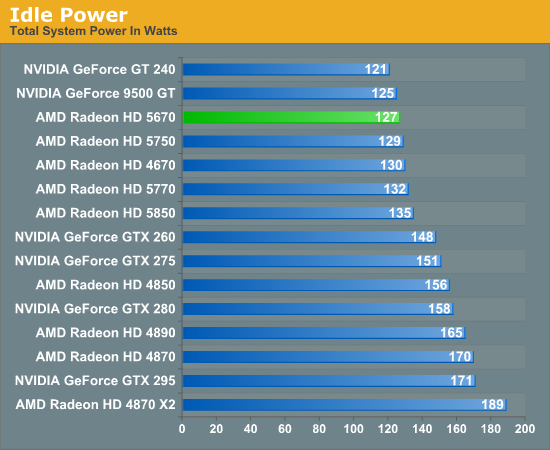
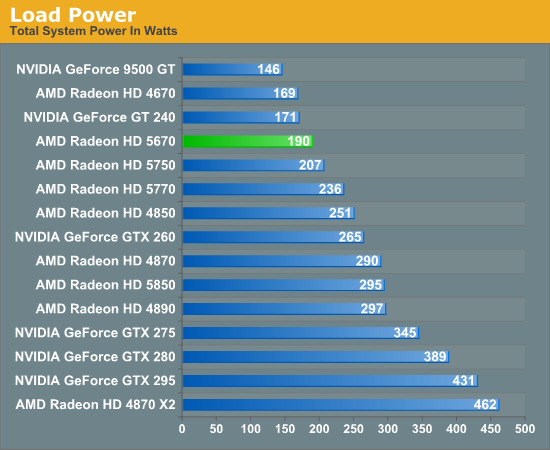
The one thing AMD can’t quite best the GT 240 at is idle power. Here the GT 240’s sub-10W idle means the 5670 idles slightly higher. With that said it’s the 3rd lowest card of all time, behind only the GT 240, and the significantly slower 9500 GT.
Load power paints a different picture however, and this is where the concept of a “power virus” pokes its head up again. The 5670 has a lower TDP than the GT 240 according to the specs published by AMD and NVIDIA - at 61W and 70W respectively - and we have no reason to doubt these numbers. But here the load power of the 5670 is much higher, by just shy of 20W. You’ll notice here that the 4670 is also much lower in spite of similar specs – all of this leads us to believe that the other cards are throttling themselves some as compared to the 5670, whose VRM protection features let it run away compared to these cards. Compared to the 5750 the data is correct, so that makes a better reference point than the GT 240 or 4670.
Accounting for these quirks, the 5670 should be between the 3rd and 2nd lowest power consuming card that we have on-hand.
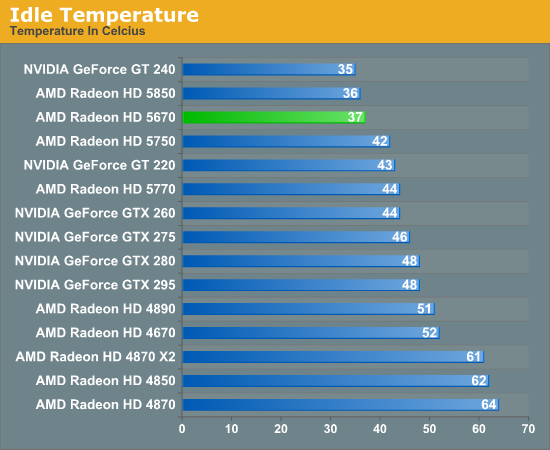
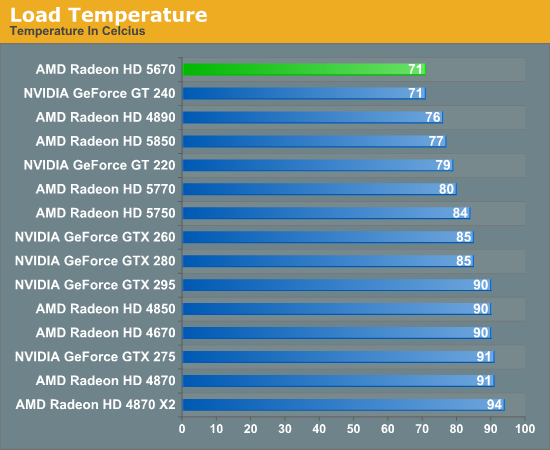
Less power usage leads to less heat, and in this case this means the 5670 once again trails the GT 240, which benefits from said lower power usage and the dual-slot cooler on our specific card. It’s still the 3rd best card however, beating everything except said GT 240 and the remarkably cool 5850.
At load, the picture looks very good for AMD. Even though we’re using a dual-slot cooler, thanks to the low load power usage we’re looking at a tie for the lowest load temperatures we’ve ever recorded. The dual-slot GT 240 ties at 71C, and we’re several degrees from anything else. The results are particularly good compared to the 4670, which was an inferno at 20C higher in this test.
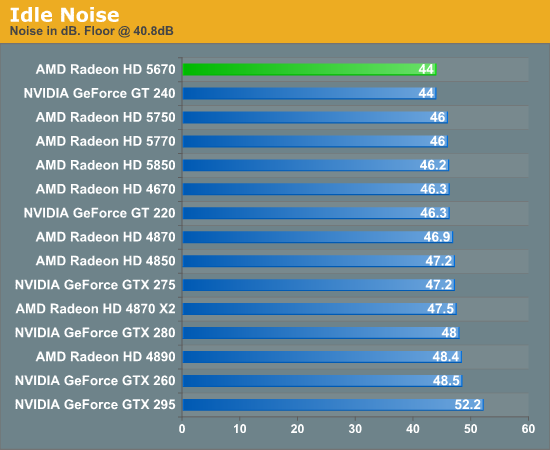
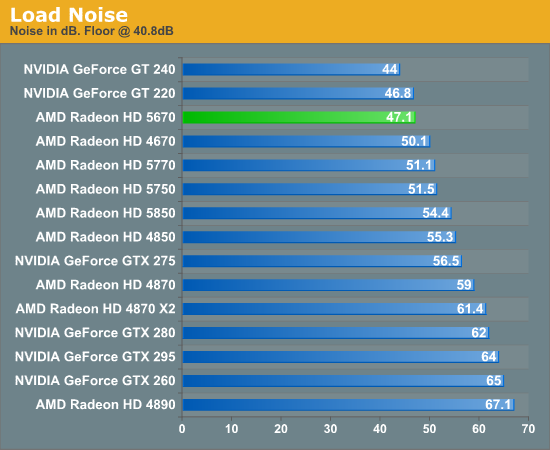
Finally there’s noise. As is the case with all of our other cards, the noise at idle is virtually indistinguishable from the noise generated by the rest of the computer.
At load the 5670 continues to be a quiet card, at only 3dB louder than idle. The only thing it falls behind here are the GT 220 and GT 240, both of which use dual-slot coolers and can afford the use of a larger, quieter fan. This is actually very impressive for a single-slot blower.
All of this data points to the 5670 making for a good HTPC card, certainly one as good if not better than the GT 200 series, and definitely better than the 4670. It’s cool and quiet, everything an HTPC card needs. However we’re more interested in where the 5500 series would place here – few HTPCs need this much rendering power, and with the 5500 series sub-50W power draw, it may be an even better choice.










73 Comments
View All Comments
Calin - Thursday, January 14, 2010 - link
These lower end series are not intended to run high resolution monitors in "heavy" games at performance modes. For that, there is the 5800 series.These 5600 series seems ok for every game in 19" resolutions and lowered quality, which make them perfect for many people. They are a huge step up from integrated graphics :)
BelardA - Thursday, January 14, 2010 - link
How many people actually buy 19" displays anymore? Wide screen isn't like the older 4:3 screens, so a 19" LCD is kind of small.At $125~150, there isn't much reason to NOT get a 20~21" class monitor.
While the 5600s are a bit on the slow side, there is a NEED to have low-end graphics cards that meets some standards and having an entire product line support DX11 is still a good thing.
Once the price of the 5670 gets down to $75 then it will be a good value card. But not at $100~120 which is the current price on Newegg. And remember, many people don't have the PSUs (or budget) to get support a 5700 series card. I think once 40nm manufacturing matures for TMSC (sp?), the pricing will go down more.
As an owner of a 4670, the 5670 is easily a faster card... but I believe AMD screwed up. The $100 4770 was almost on par with the 4850 and easily faster than the 4830. There is NO reason the smaller die 5670 to be ANY slower than the 4770. That is ALL the 5670 needed to be. But then again, the $135 (today) 5750 is starting to be constantly faster than the 4850 card (good).
SO the real problem is pricing. If the $100 5670 was almost as fast as the $135 5750, there would be no need for the 5750. Also, other than PSU requirements - it would be stupid to spend $120 for a 1GB 5670 when the 5750 is $15 more and almost twice the performance.
Zool - Thursday, January 14, 2010 - link
"They are a huge step up from integrated graphics :)"Price wise the 5670 is a huge step too from integrated graphic. I was mainly comparing the 5xxx and 4xxx series and thats almost a zero jump.
Zool - Thursday, January 14, 2010 - link
But of course why should AMD compete with itself when it still beat everything that nvidia has in price.I think i will skip this generation too and wait for the 6K cards.
Zool - Thursday, January 14, 2010 - link
The 5700 cards are on the same level than 4800 cards and the 5600 cards are very close to 4600 cards. Now if u enable DX11 in games u will se performance way below both 4800 and 4600 for both dx11 cards against they counterpart. Thats downgrading not upgrading.And the X700 vs X800 series trick and price range change is quite disturbing too.
Zool - Thursday, January 14, 2010 - link
How can game developers make better looking games when the performance/price sits on the same level with each generation ? DX11 is very taxing if u want to make it properly. Those fancy new efects, postprocessing with Dx compute just eats much more shader power,bandwith. Performance wise 4800 owners can upgrade only to 5800 cards (dx11 speeds with 5700 is very weak) which price level is another category.But that can happen if your only competition is rebranding a 2006 card architecture because the GT200 was overdesigned. The disturbing part of this is that nvidia cant learn from its mistakes and make another giant chip second time GT300 which is this time even late :).
Zool - Thursday, January 14, 2010 - link
Its quite strange that they downgraded the 5670 TMUs from 32 to 20. With the 60+ GB/s the 32 TMUs could be much more usefull than with the 4670 bandwith. All games use multitexturing to some degree quite some time.Spoelie - Thursday, January 14, 2010 - link
Far Cry 2: the text states that the 5670 and the 4850 have the same amount of memory and that the 5670 beats the 4850.However, looking at the test setup, the 5670 is the 1GB version and the 4850 is the 512MB version, and the test results support this. The gap between the 4850 and the 4870 is *way* too big to not be memory size constraint.
As such, the only reason the 5670 "beats" the 4850 in this test is the memory size, and the supporting text is wrong.
Ryan Smith - Thursday, January 14, 2010 - link
The 5670 is 512MB.The facts have been corrected to fit with reality.
Spoelie - Thursday, January 14, 2010 - link
hmmm ok, then the Far Cry 2 results are a bit peculiar. The 4850 has the same amount of memory but more of everything else and is 25% slower. The performance of the 5670 seems to fall in line with its compute resources, as if it doesn't have a memory bottleneck. This made me think you had a 1GB card. My apologies.